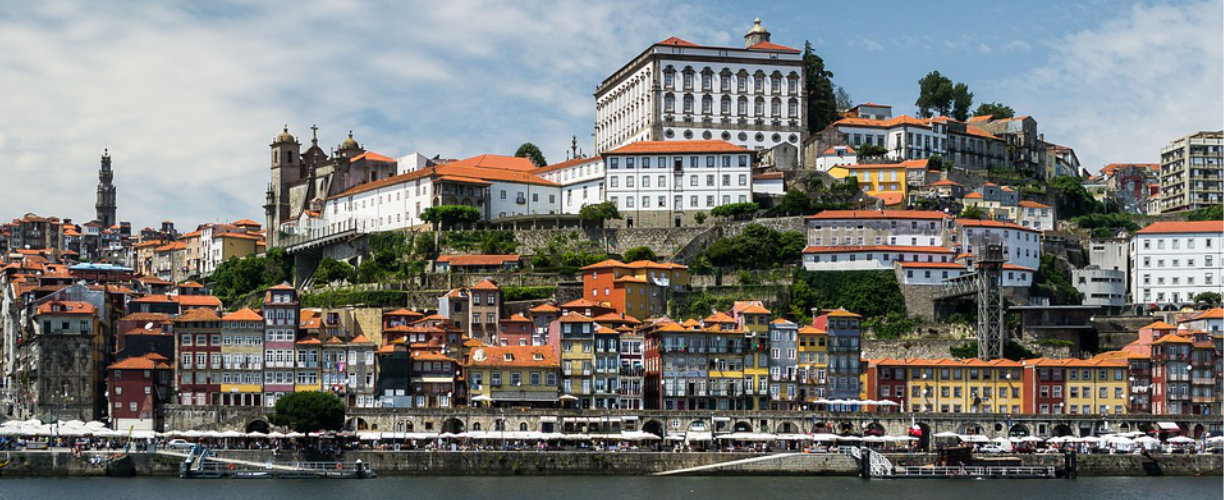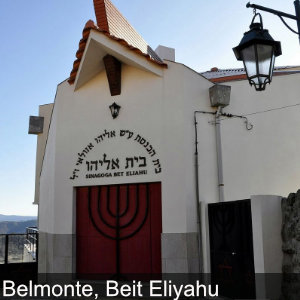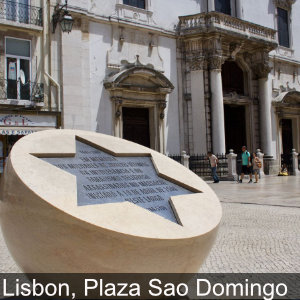
Portugal… in search of Sefarad (Jews of the Iberian Peninsula)
Overview / Highlights
9 NIGHTS / 10 DAYS The Jewish presence in the Iberian Peninsula existed long before Portugal itself became a country. The contribution of Portuguese Jews to the arts, philosophy, commerce and sciences, helped create the cultural heritage of this nation. As is typical in Jewish history, the Jewish existence in Portugal does not end on a high note, and the Jews are confronted by forced conversions, leading to pogroms and massacres. Our tour will bring Portugal's Jewish history to life by visiting regions and places of Jewish interest, including descendants of the Inquisition, often referred to in Portuguese as Conversos also known as the B'nai Anusim (Children of Oppression). Forced to convert, many continued their Jewish practices in secret.
Tour Program Summery Outline
|
Click |



Day 1, Sep 3, 2020: Depart the USA
Departure from your home city for overnight flight to Porto, Portugal. (flights are optional not included in this quote)Day 2, Sep 4, 2020: Arrive Porto (Kadoorie Mekor Haim Synagogue visit)
Welcome to Porto, a coastal situated in northwest Portugal known for its stately bridges and port wine production. In the medieval Ribeira (riverside) district, narrow cobbled streets wind past merchants' houses and cafes. The history of the Jewish community of this ancient city is inseparable from the history of Portugal.Porto is a city of commercial tradition and attracted Jewish traders during the Middle Ages. This was home to a thriving Jewish community of merchants, many of whom had their offices along the Porto riverfront in the Ribeira area along the Rua da Alfandega. Another Jewish community once flourished at the Rua Monte dos Judes, where in 1826 an important ancient Hebrew plaque was unearthed. The main synagogue of the Jewish quarter was recently discovered during renovations on an ancient building. Behind a false wall, workers stumbled onto an ark thought to be from the 15th century.
We will also visit the Kadoorie Mekor Haim Synagogue, the largest Synagogue in the Iberian Peninsula and one of the largest in Europe. Built with donations from Jews from all over the world, it was inaugurated in 1938, at a time when Synagogues were being burned in Germany.
This Synagogue is a singular architectural monument, and one of the most extraordinary places of Jewish worship in the world. It is also the headquarters and "heart" of the Jewish Community of Porto (Oporto in Portuguese), founded in 1923 by Captain Barros Basto, who became known in the Jewish world for his efforts to rescue the descendants of the Jews who were forced to convert in the 15th century and who continued to practice, in secret, certain precepts of the Jewish religion. We will visit the Jewish Museum located at the synagogue covering the history of the Jewish community of Porto from the Middle Ages to the present times.
Overnight and dinner at the Sheraton Porto Hotel. (L,D)
Day 3, Sep 5, 2020: Porto (City Tour & Brief Evening Cruise)
Porto is considered the most popular European destination in recent years and today we resume our tour of the city, visiting many sites that make Porto such a great destination including; the massive main square with City Hall at its top, the tile adorned St. Bento Train Station, the 12th century Sé Cathedral, Italian designed Clerigos Tower and Church, the third most beautiful bookstore in the world - Lello Bookstore, the 19th century Stock Exchange Palace, the busy Ribeira esplanade set on the famous Douro River where you can view the port wine cellars and traditional rabelo boats that were used to transport port wine as well as the expansive bridges that span the banks of Porto and Vila Nova de Gaia.We will stop for a traditional Portuguese style lunch in either the busy Ribeira Square or in a nearby fishing village to enjoy the 'catch of the day' and the locals!
This evening a special treat as we follow in the footsteps of the wine merchants of Portugal on a classic 50-minute "Six Bridges" cruise of Porto. Sail down the River Douro along the route of the old "Rabello Boats" that served Porto and Vila Nova de Gaia. Reach the Foz do Douro, and more.
Overnight and dinner at the Sheraton Porto Hotel. (B,L,D)
Day 4, Sep 6, 2020: Porto (Douro Valley & Wine Tasting)
The Douro is one of the major rivers of the Iberian Peninsula, flowing from its source near Duruelo de la Sierra in Soria Province across northern-central Spain and Portugal to its outlet at Porto.The Douro Wine Region is the oldest demarcated wine region in the world, dating from the 18th century. The amazing landscape of the vineyards in the slopes is unique and the reason why the landscape is considered to be UNESCO world heritage.
Our tour begins with a visit to a Port wine producer. There will be a personalized guided tour on the vineyards where the process of making the Port wine will be explained. The wine tasting will be accompanied by a careful selection of Portuguese cheeses.
Lunch will be served in a typical Portuguese restaurant and will be given the choice of meat, fish or vegetarian.
The second winery is a small table wine producer. The visit will be private to the group where the guide will give more importance in explaining the difference between premium wines and the different ways of winemaking. The visit ends with an olive oil tasting.
Overnight and dinner Sheraton Porto Hotel. (B,L,D)
Day 5, Sep 7, 2020: Porto – Aveiro – Coimbra
We depart to Aveiro, often dubbed as ‘The Portuguese Venice’, a charming city crossed by a channel, where colored Moliceiros boats navigate and with buildings in pastel shades of Art Nouveau style. The traditional sweet is Ovos Moles which are presented in different shapes, and the Tripas from Aveiro.The saltworks from Aveiro are among the most well-known saltworks in Portugal, and here we can learn how the salt appears and is extracted. There are those who say that the Salt Worker is lazy because he lives from what nature gives him. But the wisdom of the Salt Worker lies in being capable of relating the salted water, the wind, the sun and the rain, the clayey muds, the seaweed and the wood of the tools, creating what once was the great engine of the world economy, salt.
Our next stop Coimba. Rising from the Rio Mondego, Coimbra is a city steeped in history. It was Portugal's medieval capital for more than a century and its home to the country's oldest and most prestigious university. Its historic center dates to Moorish times and offers a unique atmosphere with its dark cobbled lanes and monumental cathedrals. On summer evenings, the city's old stone walls reverberate with the haunting metallic notes of the guitarra (Portuguese guitar) and the full, deep voices of fado singers. The city is at its best during university term time when the students bring a youthful energy to the streets, thronging bars and partying late into the weekend. Their presence also adds a political edge - witness the graffiti scrawled outside the repúblicas (communal student dwellings) addressing the political issues of the day.
Time permitting, we will visit the University of Coimbra. Founded in 1290, the University of Coimbra (UC) is one of the oldest universities in the world and the oldest in Portugal. Up until the early part of the 20th century, it was also the only Portuguese-speaking university in the world. Built in the grounds of a former palace, its 16th century campus is classified as a UNESCO World Heritage site.
Overnight and dinner at the Quinta das Lagrimas Hotel. (B,L,D)
Day 6, Sep 8, 2020: Coimbra – Viseu – Trancoso – Belmonte
This morning we head to Viseu, a city and municipality in the Central Region of Portugal and the capital of the Viseu District. During the Middle Ages, the city often served as the court for various Visigothic nobles, such as King Roderic, and is considered as the probable birthplace of Afonso Henriques, first King of Portugal.Next, we head to Trancoso, a tiny village in northern Portugal that was once home to a large flourishing Jewish community that ended with the arrival of the Inquisition. In 2012 it honored its Jewish heritage with the establishment of the ‘Isaac Cardoso Center for Jewish Interpretation’ and a new synagogue called Beit Mayim Hayim – ‘The House of Living Waters.’ The Jewish presence in Trancoso predates the fourteenth century, it is very likely that by the time the St. Bartholomew's Fair was created in 1273, Jews already lived here. D. Pedro I granted him in 1364 separate Jewry sections representing half the village. They were wealthy, as well as cobblers, merchants, weavers or tailors, lending money, owning land, and living off renting houses. Some had privileges of the king as was the case of David Borcas server of Gonçalo Vasques Coutinho, chief mayor of Trancoso who was dismissed from the exercise of communal positions.
In the fifteenth century, the Jews of Trancoso asked King D. João II to expand the synagogue due to the increase in population. And in the following century they were the largest community of Beira Interior, at this time more than five hundred Jews would live here. The Jewish heritage of Trancoso manifests itself through written documentation and customs, but also in the material aspect, with the House of the Black Cat or Lion of Judah, the Well of the Master, and some interesting architectural elements, inscribed in the buildings along the Historic Center. This legacy justified the construction of the Isaac Cardoso Jewish Culture Interpretation Center and the Casa do Bandarra.
Next is we head to Belmonte, situated in the remote and beautiful region of Portugal, rich in the history and traditions. While most of the towns in central Portugal are suffering through difficult economic times, this small village northeast of Lisbon is enjoying a revival: The past decade has seen the construction of a luxury hotel and a museum, and tourism is booming. The cause? Jews, or more like the Conversos, to be exact. Belmonte, a town of 3,600, is home to some 300 descendants of Jews who survived the Inquisition by practicing their religion in secret - the only sizable community of these "secret Jews" to remain on the Iberian Peninsula. Until the 1990s, the Belmonte Conversos kept their history to themselves. But since warily emerging from secrecy, the Jews here have generated a small local economy in one of the most economically depressed regions of Western Europe - one that is benefiting Jew and non-Jew alike.
The old Jewish quarter was located around the current “Rua Direita” e “Rua Fonte da Rosa” (the primitive Jewry Street). At the top of “Rua Direita” there’s a square, one of the oldest in Belmonte, which preserves a lot of its primitive architecture. There we can see small stone houses, with small openings and crosses in the doorjambs.
We do not know much about the beginnings of the Jewish community in Belmonte but a stone of the first Synagogue dated back from 1297 ensure us that it is a very ancient community. The Beit Eliahu Synagogue was inaugurated in 1996, precisely 500 years after the decree prohibiting Judaism in Portugal.
In 2011 Portugal created the Portuguese Network of Jewish Quarters intended to combine historical and heritage recovery with tourism promotion that also helps to discover a strong Portuguese and mainland identity.
The contribution of the Portuguese Jews in our history was enormous; from the nautical science that more than 500 years ago gave a breakthrough to the onset of globalization, to the evolution of the world economy and medicine, many were the areas where the role of Sephardic Jews has become more prevalent. Belmonte has today the national headquarters of the Network, the Bet Eliahu Synagogue and the Jewish Museum.
Overnight and dinner at the Pousada Convento de Belmonte Hotel. (B,L,D)
Day 7, Sep 9, 2020: Belmonte – Castelo de Vide – Tomar – Lisbon
Our first stop is Castelo de Vide. Spreading over the hillside around the town's mediaeval castle is an intricate network of picturesque narrow streets that once housed a large community of Portuguese Jews, traces of which have been carefully preserved until the present day. Despite several references to earlier times, it was really in the 14th century that this Jewish quarter began to consolidate itself, stretching from the Castle to the Fonte da Vila (the town's granite fountain) and as far as the Rua Nova. The building which is generally considered to be the old synagogue is located oil the corner of Rua da Judiaria and Rua da Fonte and has recently been completely restored. In addition to the space set aside for worship and the special compartment reserved for women, archaeological studies have permitted the discovery of three silos on the lower level, dug out of granite and used for the storage of grain. Next to this stood the school, with its entrance through a pointed arch, similar to the two that afford access to the entrance to the synagogue. Other buildings, in the same street, formed part of the complex that housed the civil and religious services of the local Jews.After the order was given for the expulsion in 1496, many Jewish families remained in Castelo de Vide, converting to Christianity, and, because of their high intellectual standing, distinguishing themselves in different activities. It was here that Garcia da Orta was born, the author of "Colóquio dos Simples e Drogas da India," one of the most important works of medical and botanical science published in the 16th century.
We continue our way towards Tomar, a small historic village 145 kilometers north of Lisbon, an interesting region that was a strong hold for the Knights Templar religious order. The remains of their fortress and a monastery are still intact and open as a museum. Buried away in one of the narrow streets of the old Jewish quarter rests the oldest existing synagogue in Portugal dating back to 1438. After the forced conversions that followed in 1496; the synagogue was used as a prison, a church, a hayloft and finally a warehouse. In 1921 the building was declared a national monument and in 1939 the owner, Samuel Schwartz donated it to the state for use as a museum. A mikveh was discovered next door during excavations of the outbuilding in 1985. A prosperous Jewish community developed here back in the 14th and 15th centuries in what is called "the lower town", or town below. We will visit the Abraham Zacuto Museum (Abraham Zacuto was a famous Spanish astronomer, astrologer, mathematician, rabbi and historian who served as Royal Astronomer in the 15th century to King John II of Portugal). The Museum displays numerous ancient tablets, gravestones, texts, and artifacts showing all aspects of Jewish life in ancient Portugal.
Next, we visit Convent of Christ. In 1983, UNESCO awarded the classification of world heritage to the Templar Castle and the Convent of the Knights of Christ in Tomar, a unique monument in the history of the western world. Here we follow the footsteps of the Knights Templar, a religious-military order full of mysteries with a great treasure that would include the Holy Graal. This order spread through Europe and Middle East and arrived in the Iberian Peninsula at the time of the "Christian Reconquista". Regarded as a holy war, Knights Templar had a key role in these wars and during the Portuguese Age of Discoveries. Continue to Lisbon for overnight.
Overnight and dinner at the Dom Pedro Hotel Lisoba. (B,L,D)
Day 8, May 10, 2020: Lisbon – Sintra – Óbidos – Lisbon
Today we tour Lisbon's environs. First stop medieval Sintra, a resort town in the foothills of Portugal's Sintra Mountains, boasting a forested terrain and studded with pastel-colored villas and palaces and former summer resort of Portugal's monarchy. Here we visit the Moorish- and Manueline-style Sintra National Palace distinguished by dramatic twin chimneys and elaborate timework. The hilltop 19th-century Pena National Palace is known for its design and views. Time permitting, we will stop at Cabo da Roca. It is a wild and rugged headland marking mainland Europe's most westerly point. The windswept cliffs of Cabo de Roca were believed to be the edge of the world up until the up until the late 14th century and the desolate scenery adds to the allure of the location.We continue to Óbidos, a walled town, with narrow streets spreading from the foot of the castle, still preserves all the atmosphere of a 16th century mediaeval town. The Jewish quarter, an area was once inhabited by traders, artists and scientists, was in the center of the town, close to the Rua Direita and the beautiful 16th century Renaissance church of Santa Maria, where it is possible to appreciate the paintings of Josefa d'Obidos, one of the most important 17th century Portuguese artists. Since it was the property of the queens of Portugal, Obidos always enjoyed special protection from the royal court and at one time had a school of arts and sciences. The effects of all this culture are clearly evident in its artistic heritage, in particular the Manueline palace that was built inside the castle walls (now converted into the Obidos Pousada). Return to Lisbon for overnight.
Overnight and dinner at the Dom Pedro Hotel Lisoba. (B,L,D)
Day 9, Sep 11, 2020: Lisbon
Lisbon, Portugal’s Capital City stands in northern bank of Tejo (Tagus) river estuary. It was colonized by many civilizations along the centuries: Phoenicians, Greeks, Carthaginians, Romans, Moors and finally the Portuguese after 1147. The view over the city from the walls of the St. Jorge’s Castle is magnificent, allowing to understand why the Portuguese Kings lived there for some centuries until the Golden age of the Discoveries.Jewish heritage in Lisbon can be traced beginning with the Alfama quarter, a large community which included the Judiaria Grande and included the Rua da Judiaria. These narrow streets still evoke the spirit of the generations of Portuguese Jews who lived and flourished there. As the community grew, more Jewish refugees came to Lisbon, a new Judiaria Pequena was formed in the 13th century near what is today known as the central Praça do Comércio. This entire area was destroyed by the 1755 earthquake. The nearby Rossio square, before the earthquake, was the site of the court of the Inquisition. It was there where Jews and other accused heretics were burned at the stake. There is also the National Museum of Ancient Art, where you will find a primitive Portuguese masterpiece, including Jews wearing Stars of David on their clothing and a rabbi opening the Talmud, as well as other paintings with Jewish themes.
Praça do Rossio is the city’s liveliest area, where many locals and tourists meet up. The square and its surrounding streets are packed with some of the city’s most famous restaurants, bars and shops; it’s also the site of the Jewish Lisbon Memorial. This memorial to the victims of the 1506 Jewish Massacre was erected on April 19, 2006 — the 500th anniversary is also known as “Lisbon Massacre,” “Lisbon Pogrom,” or “The 1506 Easter Slaughter” and located at the historic square Largo de Sao Domingos, located by the Church Igreja de Sao Domingos. Explaining this Jewish massacre begins with the inception of the Spanish Inquisition in 1492, when 93,000 Sephardic Jews fled Spain and took refuge in Lisbon. In the early 1500s, drought and plague swept through Portugal. Jews preparing Passover feasts (using unleavened bread and bitter herbs) were thought to have caused the plague/drought, with Easter and Passover in close proximity in 1506. It is estimated that between 2,000 to 4,000 Jews who were forced to convert were killed.
In the beginning of the 20th century the Shaare Tikva Synagogue was built in the center of the city. With its hidden façade (because of the strict rules that were imposed on the Jewish buildings in the past) it still is the meeting point of the Jewish community of Lisbon
Lisbon’s main synagogue called Shaare Tikva, or Gates of Hope, is a historical synagogue in Lisbon. It was built in the early 20th century as Jews, some but not all Portuguese descent, returned to Portugal from Gibraltar and North Africa. The main facade of the synagogue faces an inner courtyard, since Portuguese law at the time forbade non-Catholic religious institutions from facing the street. Inaugurated in 1904, the Lisbon Synagogue was the first synagogue to be built in Portugal since the late 15th century and was designed by one by one of the country’s best-known architects, Miguel Ventura Terra. The synagogue served as the center of Jewish life in Lisbon and was a sanctuary for the thousands of Jewish refugees who passed through Portugal during World War II. The marble Torah ark is inscribed with the Ten Commandments and encrusted with a gold leaf. It is also the home of a collection of documents dating from the 17th through the 20th centuries. Overnight and dinner at the Dom Pedro Hotel Lisoba. (B,L,D)


